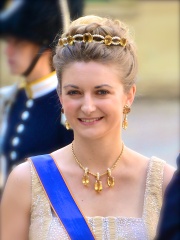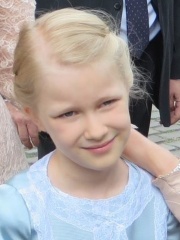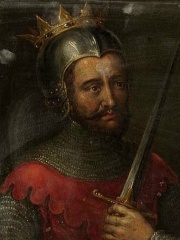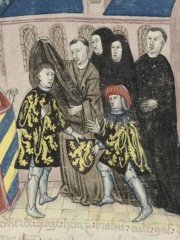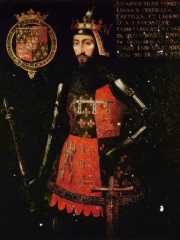

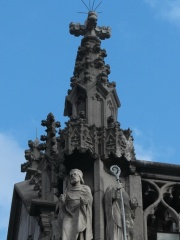
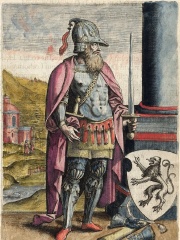
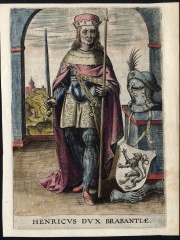
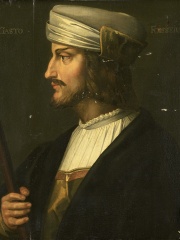
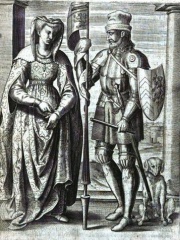
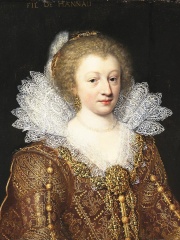
The Most Famous
NOBLEMEN from Belgium
Top 10
The following people are considered by Pantheon to be the top 10 most legendary Belgian Noblemen of all time. This list of famous Belgian Noblemen is sorted by HPI (Historical Popularity Index), a metric that aggregates information on a biography's online popularity. Visit the rankings page to view the entire list of Belgian Noblemen.

1. John of Gaunt (1340 - 1399)
With an HPI of 81.03, John of Gaunt is the most famous Belgian Nobleman. His biography has been translated into 55 different languages on wikipedia.
John of Gaunt, Duke of Lancaster (6 March 1340 – 3 February 1399), was an English prince, military leader and statesman. He was the fourth son (third surviving) of King Edward III, and the father of King Henry IV. Because of Gaunt's royal origin, advantageous marriages and some generous land grants, he was one of the richest men of his era and an influential figure during the reigns of both his father and his nephew, Richard II. As Duke of Lancaster, he is the founder of the royal House of Lancaster, whose members would ascend the throne after his death. His birthplace, Ghent in Flanders, then known in English as Gaunt, was the origin of his name. John's early career was spent in France and Spain fighting in the Hundred Years' War. He made an abortive attempt to enforce a claim to the Crown of Castile that came through his second wife, Constance of Castile, and for a time styled himself as King of Castile. When Edward the Black Prince, Gaunt's elder brother and heir-apparent to the ageing Edward III, became incapacitated owing to poor health, Gaunt assumed control of many government functions and rose to become one of the most powerful political figures in England. He was faced with military difficulties abroad and political divisions at home, and disagreements as to how to deal with these crises led to tensions between Gaunt, the English Parliament and the ruling class, making him an unpopular figure for a time. He helped forge the 1386 Anglo-Portuguese alliance, secured through the marriage of his daughter Philippa to John I of Portugal, which endured for centuries. John exercised great influence over the English throne during the minority of King Richard II (Edward the Black Prince's son) and the ensuing periods of political strife. He mediated between the king and a group of rebellious nobles, which included Gaunt's own son and heir-apparent, Henry Bolingbroke. Following Gaunt's death in 1399, the Lancastrian estates and titles were declared forfeit to the Crown, and the now disinherited son, Bolingbroke, was branded a traitor and ordered into exile. Henry did not stay in exile; he raised an army to reclaim his inheritance and depose Richard. He reigned as King Henry IV (1399–1413), the first of the descendants of John of Gaunt to hold the English throne. John cultivated an extensive network of retainers, known as the Lancastrian affinity, which became the cornerstone of his political power and was later inherited by his eldest surviving son, Henry, the future King Henry IV. All English monarchs from Henry IV onwards are descended from John of Gaunt. His direct male line, the House of Lancaster, ruled England from 1399 until the Wars of the Roses. Gaunt fathered additional children surnamed Beaufort (from the name of one of Lancaster's fiefs in France), by Katherine Swynford his long-term mistress. After he married Swynford (his third marriage), his Beaufort children were later legitimised by royal and papal decrees. Through his daughter Joan Beaufort, Countess of Westmorland, he was an ancestor of the Yorkist kings Edward IV, Edward V and Richard III. Through his great-granddaughter Lady Margaret Beaufort he was also an ancestor of Henry VII, who married Edward IV's daughter Elizabeth of York, and all subsequent monarchs are descendants of their marriage. Two of John's daughters married into continental royal houses (those of Portugal and Castile). Through them, many royal families of Europe can trace lineage to him.

2. Philippe of Belgium (b. 1960)
With an HPI of 77.85, Philippe of Belgium is the 2nd most famous Belgian Nobleman. His biography has been translated into 85 different languages.
Philippe or Filip (born 15 April 1960) is King of the Belgians. Philippe is the eldest child of King Albert II and Queen Paola. He succeeded his father upon the former's abdication for health reasons on 21 July 2013. He married Mathilde d'Udekem d'Acoz in 1999, with whom he has four children. Their eldest child, Princess Elisabeth, is first in the line of succession.

3. Pepin of Landen (585 - 640)
With an HPI of 74.02, Pepin of Landen is the 3rd most famous Belgian Nobleman. His biography has been translated into 40 different languages.
Pepin I (also Peppin, Pipin, or Pippin) of Landen (c. 580 – 21 February 640), also called the Elder or the Old, was the Mayor of the palace of Austrasia under the Merovingian King Dagobert I from 623 to 629. He was also the Mayor for Sigebert III from 639 until his death.

4. Godfrey I, Count of Louvain (1060 - 1139)
With an HPI of 68.28, Godfrey I, Count of Louvain is the 4th most famous Belgian Nobleman. His biography has been translated into 25 different languages.
Godfrey I (Dutch: Godfried, c. 1060 – 25 January 1139), called the Bearded, the Courageous, or the Great, was the Landgrave of Brabant, Count of Brussels and Leuven (Louvain) from 1095 to his death and Duke of Lower Lorraine from 1106 to 1129. He was also Margrave of Antwerp from 1106 to his death.
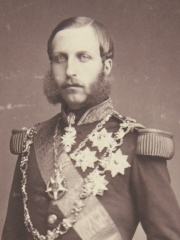
5. Prince Philippe, Count of Flanders (1837 - 1905)
With an HPI of 67.97, Prince Philippe, Count of Flanders is the 5th most famous Belgian Nobleman. His biography has been translated into 32 different languages.
Prince Philippe of Belgium, Count of Flanders (Dutch: Filips; 24 March 1837 – 17 November 1905), was the third born and second surviving son of King Leopold I of Belgium and Louise d'Orléans. He was the brother of Leopold II of Belgium and Empress Carlota of Mexico. Born at the Château de Laeken, near Brussels, Belgium, Philippe was created Count of Flanders on 14 December 1840. In January 1869, upon the sudden death of his nephew Prince Leopold, Duke of Brabant, he became heir presumptive to the Belgian throne. In 1866, after the abdication of Alexandru Ioan Cuza, Prince of Romania, Philippe refused being named the new Romanian sovereign, and the throne was later accepted by Philippe's brother-in-law Carol I. Earlier, he had also refused the crown of Greece, which was offered to him in 1862. Philippe died in 1905. When his brother King Leopold II died in 1909, Philippe's second son ascended the Belgian throne as King Albert I.

6. Henry I, Duke of Brabant (1165 - 1235)
With an HPI of 67.26, Henry I, Duke of Brabant is the 6th most famous Belgian Nobleman. His biography has been translated into 29 different languages.
Henry I (Dutch: Hendrik, French: Henri; c. 1165 – 5 September 1235), named "The Courageous", was a member of the House of Reginar and first duke of Brabant from 1183/84 until his death.

7. Gaston IV, Count of Foix (1422 - 1472)
With an HPI of 65.16, Gaston IV, Count of Foix is the 7th most famous Belgian Nobleman. His biography has been translated into 20 different languages.
Gaston IV (27 November 1422 – 25 or 28 July 1472) was the sovereign Viscount of Béarn and the Count of Foix and Bigorre in France from 1436 to 1472. He also held the viscounties of Marsan, Castelbon, Nébouzan, Villemeur and Lautrec and was, by virtue of the county of Foix, co-prince of Andorra. From 1447 he was also Viscount of Narbonne. Through his marriage to Eleanor, heiress of the Kingdom of Navarre, he also held the title of Prince of Navarre. Gaston was a son of John I, Count of Foix and Jeanne I d'Albret. His maternal grandparents were Charles d'Albret, Constable of France and co-commander of the French army, killed at the Battle of Agincourt, and his wife Marie de Sully. Gaston married Infanta Eleanor of Navarre in 1441. Her parents were John II and Blanche I of Navarre. At the time, Eleanor appeared to have few prospects: her father was a younger son and brother of kings of Aragon, and she had two older siblings, Charles and Blanche, standing between herself and the throne of Navarre. However, family dissent and death eliminated both her siblings; Eleanor's father usurped the Navarrese crown, to which he added in 1458 the throne of Aragon (his older brother having died without legitimate children). Following the deaths of Charles and Blanche, King John promised the succession to Navarre to Eleanor and Gaston in return for their loyalty to him, which was given. When Gaston IV died in 1472, his eldest son Gaston, Prince of Viana had already died, and he was succeeded as Count of Foix by the latter's son Francis Phoebus who was only 5 years old, under the regency of his grandmother and Gaston IV's wife Eleanor of Navarre. First Eleanor, and then Francis Phoebus also became Queen and King of Navarre in 1479, linking the fate of the County of Foix to that of the Kingdom of Navarre until their incorporation into the Kingdom of France in 1607.

8. Lambert I, Count of Louvain (1000 - 1015)
With an HPI of 64.05, Lambert I, Count of Louvain is the 8th most famous Belgian Nobleman. His biography has been translated into 19 different languages.
Count Lambert "the Bearded" (c. 950 – 12 September 1015) was the first person to be described as a count of Leuven (French Louvain) in a surviving contemporary record, being described this way relatively late in life, in 1003. He is also the patrilineal ancestor of all the future counts of Leuven and dukes of Brabant until his descendant John III, Duke of Brabant, who died in 1355. He fought throughout his life towards the eventual successful establishment of his family in a long-lasting position of power, but Lambert was known throughout much of his life as a rebellious noble, from a rebel family. Lambert was eventually killed in battle at Florennes, fighting against his old enemy Godfrey "the childless", the Duke of Lower Lotharingia who represented royal authority in the region. One monastic writer, Dietmar of Merseburg, described him as the worst person in his whole country ― a country which mourned during his life, and rejoiced at his death. Historical discussion about the life of Lambert is closely connected to that of his brother and ally Reginar IV. The two brothers entered Lotharingia aggressively from France after the death of their father in exile. They battled for status over decades, and some historians believe that their families only consolidated lasting acceptance after their deaths. Reginar IV, apparently the elder brother, claimed a county based in Mons in Hainaut as something which their father Reginar III had held. The basis of Lambert's claim on Leuven is less clear. It may for example have been granted to him by his father-in-law, the French Carolingian Duke Charles. It is also unclear whether Lambert already laid claim to the Brabant lordship of Brussels within his lifetime. Van Droogenbroeck, for example, has proposed that this territory to the west of Leuven only came to Lambert's family in later generations.

9. Countess Catharina Belgica of Nassau (1578 - 1648)
With an HPI of 63.18, Countess Catharina Belgica of Nassau is the 9th most famous Belgian Nobleman. Her biography has been translated into 17 different languages.
Catharina Belgica of Nassau (31 July 1578 – 12 April 1648) was a countess of Hanau-Münzenberg by her marriage to Philip Louis II, Count of Hanau-Münzenberg. She was regent of Hanau-Münzenberg during the minority of her son from 1612 until 1626.
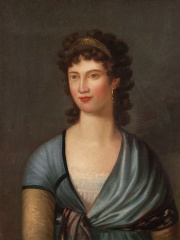
10. Princess Amélie Louise of Arenberg (1789 - 1823)
With an HPI of 63.18, Princess Amélie Louise of Arenberg is the 10th most famous Belgian Nobleman. Her biography has been translated into 17 different languages.
Princess Amélie Louise Julie of Arenberg, (full German name: Amalie Luise Julie, Prinzessin und Herzogin von Arenberg and full French name: Amélie Louise, princesse et duchesse d'Arenberg, (born 10 April 1789 in Brussels, Austrian Netherlands; died 4 April 1823 in Bamberg, Kingdom of Bavaria) was a member of the House of Arenberg by birth and, through her marriage to Duke Pius August in Bavaria, a member of the Palatinate-Birkenfeld-Gelnhausen line of the House of Wittelsbach. Amélie Louise was the paternal grandmother of Empress Elisabeth of Austria through her son Duke Maximilian Joseph in Bavaria.
People
Pantheon has 23 people classified as Belgian noblemen born between 585 and 2008. Of these 23, 8 (34.78%) of them are still alive today. The most famous living Belgian noblemen include Philippe of Belgium, Prince Laurent of Belgium, and Stéphanie, Hereditary Grand Duchess of Luxembourg. The most famous deceased Belgian noblemen include John of Gaunt, Pepin of Landen, and Godfrey I, Count of Louvain.
Living Belgian Noblemen
Go to all RankingsPhilippe of Belgium
1960 - Present
HPI: 77.85
Prince Laurent of Belgium
1963 - Present
HPI: 60.11
Stéphanie, Hereditary Grand Duchess of Luxembourg
1984 - Present
HPI: 56.23
Princess Elisabeth, Duchess of Brabant
2001 - Present
HPI: 55.39
Prince Amedeo of Belgium, Archduke of Austria-Este
1986 - Present
HPI: 50.82
Prince Gabriel of Belgium
2003 - Present
HPI: 45.55
Prince Emmanuel of Belgium
2005 - Present
HPI: 44.99
Princess Eléonore of Belgium
2008 - Present
HPI: 44.29
Deceased Belgian Noblemen
Go to all RankingsJohn of Gaunt
1340 - 1399
HPI: 81.03
Pepin of Landen
585 - 640
HPI: 74.02
Godfrey I, Count of Louvain
1060 - 1139
HPI: 68.28
Prince Philippe, Count of Flanders
1837 - 1905
HPI: 67.97
Henry I, Duke of Brabant
1165 - 1235
HPI: 67.26
Gaston IV, Count of Foix
1422 - 1472
HPI: 65.16
Lambert I, Count of Louvain
1000 - 1015
HPI: 64.05
Countess Catharina Belgica of Nassau
1578 - 1648
HPI: 63.18
Princess Amélie Louise of Arenberg
1789 - 1823
HPI: 63.18
John I, Count of Hainaut
1218 - 1257
HPI: 62.67
Gothelo I, Duke of Lorraine
967 - 1044
HPI: 62.31
Henry IV, Duke of Brabant
1251 - 1272
HPI: 62.26
Overlapping Lives
Which Noblemen were alive at the same time? This visualization shows the lifespans of the 4 most globally memorable Noblemen since 1700.


